Neutron-induced prompt gamma-ray spectrometry
Introduction
The neutron-induced prompt gamma-ray
spectroscopy (NIPS) facility was established to host a broad scope
of gamma
spectroscopic measurements. Up to now, several successful gamma-gamma
coincidence
experiments were done here, as well as experiments requiring custom
arrangements. It is now under major upgrade to turn it into a
prompt-gamma activation imaging (PGAI) and Neutron Tomography (NT)
station.
Beam line
The experimental area located in the neutron guide hall, attached to the Reactor building. NIPS station is at the very end of guide No. 1.
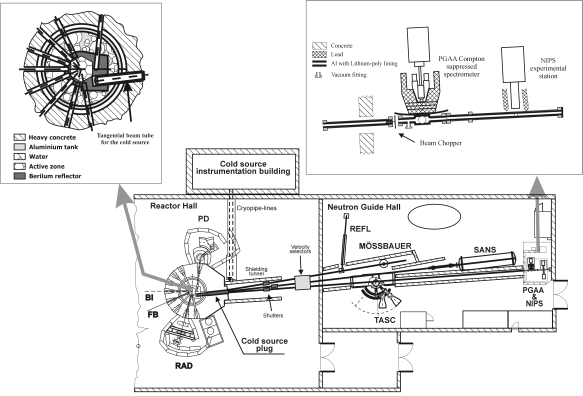
The top view of the Budapest Research Reactor, the neutron guide hall and the PGAA-NIPS facilities.
The neutron guides are surrounded by a biological shielding made of concrete. The experimental station is enclosed in a cabin made of iron screening, facilitating stable and low-noise operation of the detectors and electronics. The neutron beam is collimated into two sub-beams and the lower one serves the NIPS station, which is downstream from the PGAA system.
The aluminum flight tube is lined on the inside with slow-neutron absorber made of a 6Li
containing
plastic sheet. The distance of the sample position is 2.5 m from the end of the neutron guide.
The neutron beam is for most experiments collimated to 1x1 cm2.
Gamma-ray detection in coincidence measurements
Three different detectors can be placed around the target chamber, as close as 2.5 cm from the sample. This layout enables double, or even triple coincidence measurements of gamma rays. Besides its usefulness for the investigation of nuclear level schemes, the analytical application of the gamma-gamma coincidence technique has also been demonstrated.
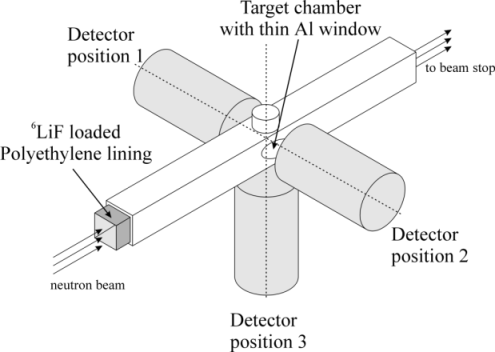
The NIPS sample chamber with three detectors, as used in coincidence measurements.
Configuration for Prompt-gamma activation imaging
In EU-wide cooperation (project ANCIENT CHARM), we have been developing a method to study the 3D elemental composition of archaeological objects. For this purpose, a computer-controlled sample positioning table is installed and a batch data acquisition software was prepared. These make possible to take hundreds of spectra from the different spots of the sample. Both neutrons and gammas are highly collimated to ensure the spatial resolution (in the order of a millimeter). Massive lead shielding is put around the HPGe detector to achieve the sufficient signal-to-background ratio. The use of multiple detectors may shorten the necessary beamtime.
The system also comprises a PCO-1600 14-bit CCD camera for neutron tomography.
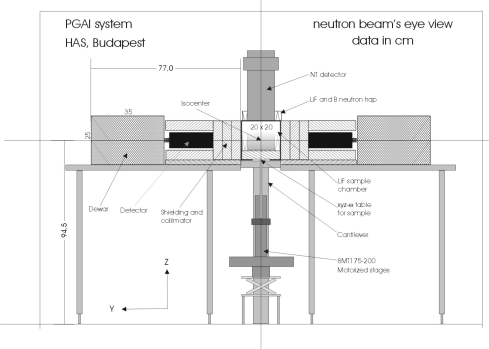
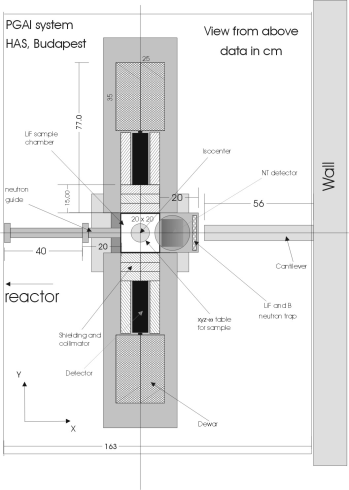
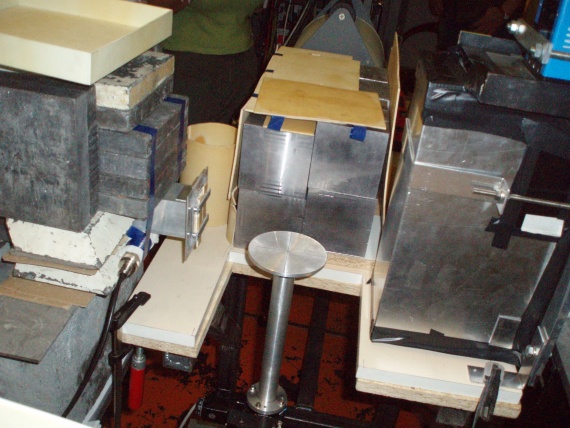
Conclusion
The NIPS facility is a proper tool for the investigation and application of radiative neutron capture when custom arrangement is needed. It is presently used for measuring the 3D elemental composition of archaeological objects.
Standard specifications of the NIPS facility
| Distance from the guide end | 2.6 m |
Beam cross section |
Max. 2 cm x 2 cm |
Thermal-equivalent flux at target |
~ 3x107 cm-2s-1 |
Target chamber Al-window thickness |
0.5 mm |
| Target chamber 6Li-window thickness | 3.0 mm |
| Beam chopping | Optional |
| Distance from the chopper | 145 cm |
|
Form of target at room temperature |
Solid, powder, liquid |
|
Target packing |
Sealed FEP Teflon bag or Teflon vial |
Activity of target after irradiation |
Negligible |
Largest target dimensions |
1.5 cm diameter, 3.5 cm length |
Distance from target to detector window |
> 25 mm |
Standard gamma-ray detector |
n-type coax. HPGe |
HPGe window |
Carbon |
Relative HPGe efficiency |
15% at 1332 keV (60Co) |
HPGe FWHM |
1.8 keV at 1332 keV (60Co) |
Gamma-ray detector 2 (optional) |
n-type coax. HPGe |
HPGe window |
Be, 0.5 mm |
Relative HPGe efficiency |
30% at 1332 keV (60Co) |
HPGe FWHM |
1.9 keV at 1332 keV (60Co) |
Gamma-ray detector 3 (optional) |
Planar HPGe |
HPGe window |
Be, 0.5 mm |
HPGe FWHM |
0.6 keV at 1332 keV (60Co) |

